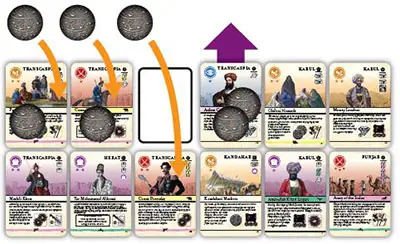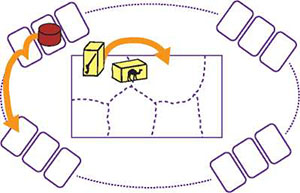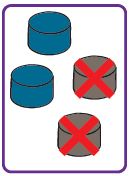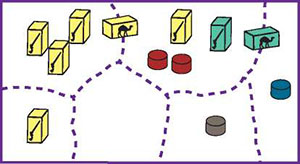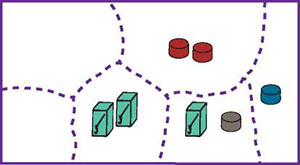
Components

- Gameboard
- 36 Coalition blocks
- 55 Cylinders
- 36 Coins
- 16 Evend cards
- 100 Court cards
- 26 Wahkan cards
- Ruler tokens
- Player boards
- Loyalty dials
- Suit Marker
Setup
Starting Favored Suit

Pax Pamir begins in a period of great political upheaval. Ayub Shah, the last of the Durrani emperors, has just been deposed. A region once unified is now on the verge of total collapse, and local authorities are taking the initiative.
To represent this political climate, place the favored suit marker on the space next to the political suit.
Build The Draw Deck
Build the draw deck using the following steps:
Separate the court cards and the event cards.
Shuffle the court cards. Create six face-down piles of court cards, each consist- ing of five cards, plus one card per player. The remaining court cards will not be used this game.
Remove the four Dominance Check event cards from the other event cards. Place one in each of the four rightmost piles.
Shuffle the remaining event cards. Place two in the second pile from the left and one in each of the remaining four piles to its right. The six remaining event cards will not be used this game.
Finally, separately shuffle each of the six piles. Then, stack the piles one on top of the other, so that the four piles containing the Dominance Check event cards are on the bottom of the deck. Do not shuffle this combined deck.
Create the Market
In Pax Pamir, cards enter play through a market. The market is an array of 12 face-up cards, arranged in a grid of two rows and six columns.
During setup, create this market by drawing cards from the draw deck and filling each market column (top row first), starting with the leftmost column. Then place the draw deck to the right of the market.
Take Player Pieces
Give each player a set of eleven cylinders, one loyalty dial, a player board, and four rupees. Place one cylinder from each player on the zero space of the victory point track and the rest on each player's player board.
Bank and Coalition Blocks
Place the remaining coins and the tray of coalition blocks near the area of play.
Starting Loyalty
Starting with a random player and proceeding clockwise, each player adjusts their loyalty dial to indicate the loyalty they have chosen. After the last player has chosen their starting loyalty, that player will take the first turn. The game is now ready to play.
Deck Construction at a Glance
Example Three Player Table Layout
Game Play
Pax Pamir occurs over a series of turns. Each turn, the active player performs up to two actions which are described in the following two sections.
Bonus actions do not count against this limit. You may opt to take only a single action or no action at all. After you have completed your turn,
perform cleanup. Then play continues clockwise to the next player until the game is over.
Cleanup
Cleanup has four steps:
First, if you have more cards than three plus the sum of the purple stars on cards in your court, discard cards in your court until you are within your limit.
Second, if you have more cards than two plus the sum of the blue stars on cards in your court, discard cards in your hand until you are within your limit.
Third, discard any event cards that are in the leftmost column of the market. Any rupees on the discarded event will remain in their position. The top row is always discarded first, followed by the bottom row. When an event card is dis- carded, all players are affected by the text or impact icon at the top of the card.
Fourth, fill any empty spaces in the market by moving all cards in that market row (along with their rupees) to their leftmost position and then draw new cards to fill in any rightmost empty spaces, returning the market to its normal size, if possible. If a card moves into a space with rupees from a previously-discarded event card, those rupees are placed on the new card taking that position.
Instability. If a Dominance Check card is revealed and there is already a Dominance Check card in the market, immediately perform a Domi- nance Check and then discard both Dominance Check
cards and fill the empty spaces in the market as described above. If the final Dominance Check card was discarded in this way, the Dominance Check will count as the final check.
Core Actions
The two core actions of Pax Pamir are described in this section. While not difficult, the purchase and play actions are, by far, the most complicated actions of the game.
When teaching the game, some groups may prefer to learn just these two actions and then introduce the other actions gradually over the first few rounds of play.
Purchase
Purchase a card from the market and add it to your hand. If you purchase a card that has rupees on it, you receive them along with the card.
In order to purchase a card, you must be able to pay the card's cost to the market.
The cost of the card depends on its current column in the market. The leftmost column is free, the next column costs one rupee, then two, etc. Pay this cost by placing one rupee on each card in the same row to the left of the card you are purchasing.
If you are ever required to place a rupee on a vacant market spot, pay the cost to the card in the same column in the other market row. If you place a rupee on a market card for any reason, you may not purchase that card this turn.
Event Cards
Event cards (including Dominance Checks) never enter a player's hand and are resolved the moment they are bought from the market. Many event cards have a persistent effect that lasts until the next Dominance Check is resolved.
Players who take these event cards should place them below their court. Event cards that alter the general game should be placed near the map in easy view of all players.

Purchasing Cards when Military Cards are Favored
If military cards are favored, the cost to purchase a card is doubled. When purchasing cards from the market, place two rupees on each card to the left of the purchased card instead of one.
Purchase Example
For his first action this turn, Chas purchases the third card in the top row. He would like to purchase a second card with his second action.
Because he already placed a coin on each of the first two cards in the top row this turn, he cannot purchase them. He decides to purchase the card "Arthur Conolly". He pays a coin to the first two cards in the top row. Because the third slot is vacant, he pays his third coin to the opposite row.
He then takes his purchased card into his hand and takes the two rupees on the purchased card.
Play
Play any card from your hand to your court.
In order to play a card, first reveal that card to everyone and announce its name and region. If you are the ruler of that card's region or if no one rules the region, you can freely play the card.
If someone else is that region's ruler, you must pay a bribe of rupees to them that is equal to the number of the ruler's tribes in that region. Any portion of this cost can be waived with the permission of the ruler. If the bribe is not paid (or waived), play continues as if the action had never been taken.
No Stacking Limit
In general, there is no limit to the number of pieces that can exist in any particular region, border, or court card. Pieces may also coexist with those belonging to different players and coalitions.
The played card may be added to either the left or right end of your court.
If the card is a patriot that does not match your loyalty, discard all of your patriots and prizes, and remove any gifts. Then adjust your loyalty dial to match that of the patriot.
After a card is played, resolve each impact icon on the right side of the card from top to bottom. The effects of impact icons are described below:

Place one coalition block of your loyalty on any border of this region. This piece is now a road.

Place one coalition block of your loyalty in this region. This piece is now an army.

Place one of your cylinders on a card in any player's court that matches the played card's region. This piece is now a spy.

Place one of your cylinders in this region. This piece is now a tribe.

Take two rupees from the bank. This card is leveraged. Reminder: If you ever discard this card, you must pay back the rupees.

Move the favored suit marker to the suit indicated.
Reminder: If the favored suit is military, the cost to take the purchase action is doubled.
Card-based Actions
The rest of the actions in Pax Pamir are associated with court cards and can only be taken if you have a card in your court which displays that action.
Each card can only be used for one action once per turn, regardless of the number of actions icons on that card.
Some card-based actions are modified by the rank of a card. The higher the rank, the more effective the action is. To help you remember this, action icons modified by rank feature additional symbols.
Bonus Actions.
Actions on cards matching the favored suit do not count against your turn's two-action limit. Remember: each of these cards can still only be used for a single action per turn.
Action Costs.
Some card-based actions require the acting player to pay an amount of rupees to cards in the market. These rupees are always paid in a similar fashion: rupees equal to the cost should be placed on the rightmost market cards of both rows, with a single rupee being paid to each card.
If a market slot is vacant, skip that vacancy and pay the next market card(s) in the row. Reminder: if you place a rupee on a market card for any reason, you may not purchase that card this turn. For an example of paying action costs, see the example of the Build Action on the next page.
Hostage Actions.
Court cards can be held hostage much in the same way that a player can rule a region. To hold a card hostage, a single enemy player must have more spies on the card than each other player.
When a card in a player's court is held hostage, that player can only use the card's actions if the player holding it hostage is paid a bribe equal to the number of hostage-holding spies on the card.
Any portion of this payment can be waived with the permission of the player holding the actions hostage. Special abilities (those described in a small text box) are never held hostage.
Hostage action example: This card is in Hope's (gray) court. Cati (blue) has two spies on the card. Hope only has one. For this reason, this card's two actions are held hostage by Cati.
To take either of this card's two actions, Hope must pay a bribe of two rupees to Cati. Cati may reduce or waive this bribe outright.
Tax
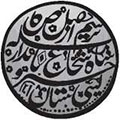
Take rupees up to the acting card's rank from players with at least one court card associated with a region you rule or any card(s) in the market (regardless of their region).
You may take rupees from several sources so long as the total taken does not exceed the rank of the acting card.
Tax Shelter. The total number of gold stars in your court indicates the amount of rupees you can shelter from the Tax Action. Only rupees you hold in excess of your Tax Shelter are vulnerable to the Tax Action.
Gift

Place one of your cylinders on one of your empty gift spaces on your loyalty dial.
Each gift will count as one influence point in your current coalition. The cost of this action is equal to the marked price of the gift placed (2, 4, or 6).
Reminder: Gifts are lost whenever you change loyalty!
Build
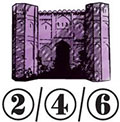
Place up to three armies and/or roads among any regions that you rule. Roads may be placed on any adjacent borders.
Any combination of different units may be purchased. The cost of this action is equal to two rupees per unit placed.
Move

For each rank of the acting card you may move one loyal army or spy. The same unit can be moved multiple times on a single turn. Likewise, multiple moves may be split across several of your spies and loyal armies.
To move an army from one region to an adjacent region there must be a road matching the loyalty of the moving army on the border being crossed.
Spies move along cards in the players' courts (clockwise or counter-clockwise), as if they formed a single continuous track around the area of play.
Move Example
Blake (red) takes a rank three move action. He is loyal to the Russian coalition. With his first two moves, he moves his spy two cards counter-clockwise. Then, with his final move, he moves his army to an adjacent region using a yellow road.
Betray
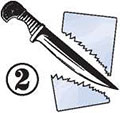
Discard one card where you have a Spy (including cards in your own court). Any spies on the betrayed card are lost and returned to their owner's supply. This action always costs two.
After the betrayed card is discarded, you may accept it as a prize, tucking it partial- ly behind your loyalty dial. If this prize is different from your current loyalty, first remove all gifts, prizes, and patriots in your court matching your previous loyalty.
Reminder: Betrayals may trigger leveraged icons and The Overthrow Rule (page 8).
Battle

Start a battle in a single region or on a court card. At the site of the battle, remove any combination of tribes, spies, roads, or armies equal to the acting card's rank. There are three restrictions to this rule:
You cannot remove more units than you yourself have armies or spies in that battle.
You cannot remove armies or roads that are of your loyalty.
You cannot remove tribes belonging to players that share your loyalty. However, their spies may be removed!
Battle Examples
Cati is loyal to the British coalition and uses a rank two battle action. She must first decide the site of the battle.
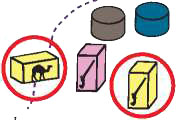
Cati selects a region. In this region she only has one loyal army, and so can only remove a single unit She cannot remove Hope's tribe (gray) because they share a loyalty.
Instead, she may eliminate the enemy road or the enemy army.
-or-
Cati (blue) selects a card on Hope's court. She removes two of Hope's spies-despite the fact that they share the same loyalty!
Cati now holds the actions on this card hostage.
Dominance Checks
Dominance Check event cards are resolved when purchased by a player or when triggered during cleanup. When re- solved, take account of the game-state.
If a single coalition has the most blocks in play and at least four more than all other coalitions (uncombined), the Dominance Check is successful. Otherwise the check is unsuccessful.
Example: If the British coalition has eight blocks and the other two coalitions both have four blocks, the British Coalition would be dominant.
The result of this check determines what happens next.
Early End
If, after scoring a Dominance Check, the leading player has at least four more victory points than the next highest scoring player, the game is over and that player wins!
Unsuccessful Check
Players will score points based on the number of cylinders they have in play. A cylinder is considered to be in play if it is not on a player board.
- The player with the most cylinders in play scores three victory points.
- The player with the second most cylinders in play scores one victory point.
If there is a tie, add up the victory points for the tied places and then divide that number by the number of tied players (rounding down) e.g. two players tied for first place will both score two points ((3+i)-2).
Successful Check
Players loyal to the Dominant Coalition score victory points based on their influence points (page 6). Each loyal player has one influence point plus the sum of their gifts, prizes, and the number of patriots in their court.
- The player with the most influence scores five victory points.
- The player with the second most scores three victory points.
- The player with the third most scores one victory point.
If there is a tie, add up the victory points for the tied places and then divide that number by the number of tied players (rounding down).
After awarding points for the successful check, the region settles into an uneasy peace. Remove all coalition blocks from the board.
Final Dominance Check
Any points earned during the final Dominance Check are doubled. This doubling occurs before any victory points are split in the case of ties for influence or cylinders.
Dominance Examples
The third dominance check has just been bought in a three player game with Cati (blue), Blake (red), and Hope (gray).
The Russian Coalition is dominant. Cati and Blake are both loyal to that coalition. Cati has the most influence and scores five points, Blake scores three.
Because the check was successful, all of the blocks are now cleared from the board.
A few turns later the fourth dominance check appears in the market and is bought. For the sake of example, there are no spies or gifts in play.
No Coalition is dominant. Blake has the most cylinders in play so he would score six points (3 x 2 for the final dominance check) Cati and Hope would each score one (1x2+2).
End of the Game
A game of Pax Pamir can end two ways. If, after any Dominance Check, a single player leads all other players by at least four victory points, the game is over and that player wins.
Barring that, after the deck's final Dominance Check is resolved, the game will always end, and the player with the most victory points wins.
If one or more players have the same number of victory points when the game ends, the player with the most red stars in their court among the tied players wins.
If there is still a tie, the player with the most rupees among the tied players wins. If there is still a tie, whoever can cook the best chopan kebab wins.
Continue Reading


